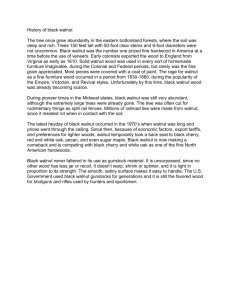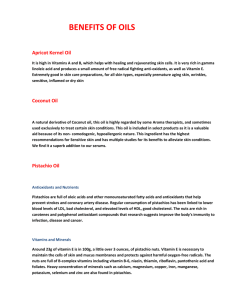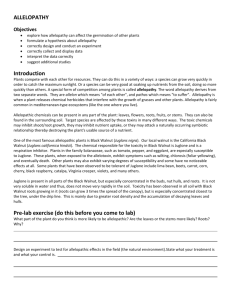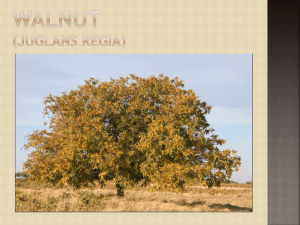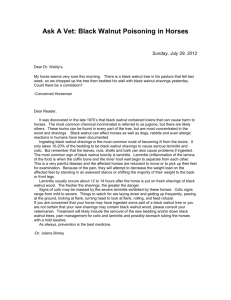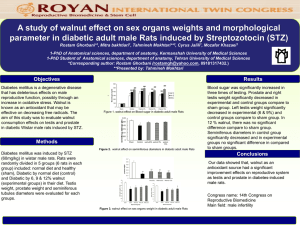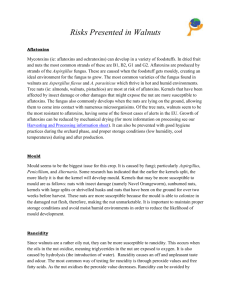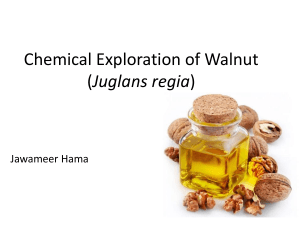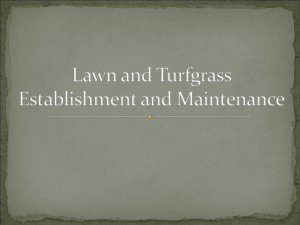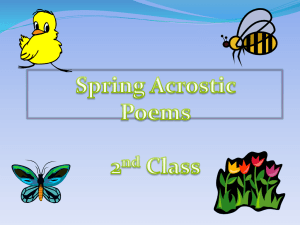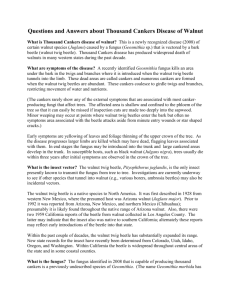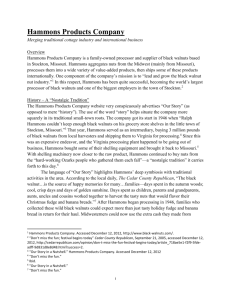Allelopathic Toxins and the Black Walnut (Juglans
advertisement
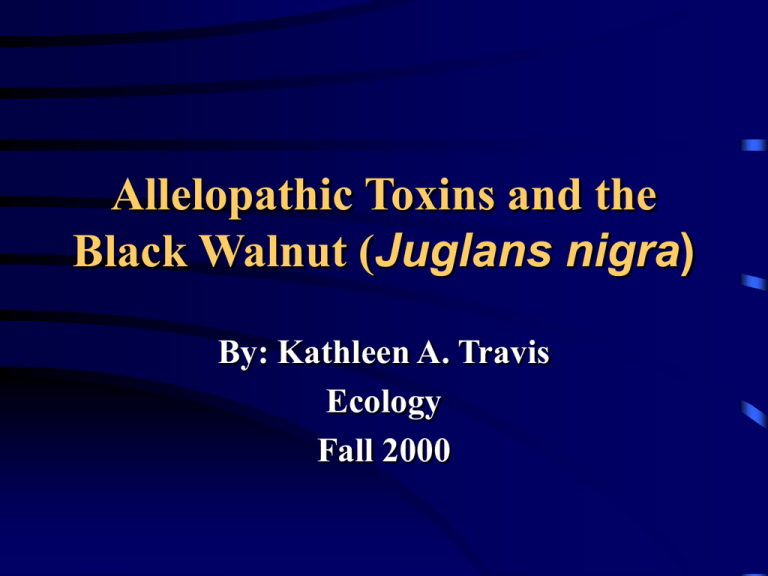
Allelopathic Toxins and the Black Walnut (Juglans nigra) By: Kathleen A. Travis Ecology Fall 2000 History • Pliny the Elder (A.D. 37) a Roman naturalist, noted the harmful effects of Black Walnut trees on the plants around them. • Native Americans would often use juices from the hull of the Walnut to poison and catch fish in small streams and ponds. Location • Black Walnut trees are found in the Midwest and East in the United States. • Some varieties of the Black Walnut are also found in Europe. Plant Allelopathy • Plant allelopathy: the secretion or admission of a toxin or chemical from one plant in order to inhibit the growth of another plant • Allelopathic chemicals themselves are a part of a diverse group of substances such as alkaloids, terpenes, and organic cyanides which can be naturally synthesize and released by plants. Mechanisms of Release • Exuded through glands on roots or in leaves • Released by the decay of fallen leaves and dead roots • Leached from the leaves when rain or fog passes over the leaf and drips off • Volatilized and then attached to soil particles Jugalone Toxin • Found in the roots, leaves, and in the husks surrounding the seeds of Black Walnut trees • Will not kill everything, but it does affect a variety of plants commonly used for landscaping and various garden vegetables Symptoms of Walnut Toxicity • Symptoms begin with the wilting of the terminal shoots followed by an irreversible wilting of the rest of the plant. (callus build in xylem) • If the plant has only a mild reaction to the toxin, poor flower development and stunted growth are noted. Experimental Objective • The objective of this experiment was to test the tolerance levels of some grasses used for landscaping purposes in this region to the jugalone toxins. A few other garden (tomatoes and potatoes) and floral (hostas and day lilies) plants were also tested for susceptibility. Procedure • Grasses chosen: Alliance Rye, Annual Rye, Kentucky Bluegrass, Wolfpack Tall Fescue, and Creeping Red Fescue. • The grass seeds were planted and allowed to grow in Bellarmine's Green House for two weeks. Each variety of grass was planted in a separate pot, and four pots of each type of grass were grown. Walnut Extract • • • • Solution #1, one walnut : one liter H2O Solution #2, three walnuts : one liter H2O Solution #3, five walnuts: one liter H2O Husk cut up before soaking to increase the amount of surface area • Soaked in a refrigerated room for two days with stirring every 12 hours • Walnuts removed and the solution was refrigerated until its use (3 days) • Solution #1, solution #2, and solution #3 were each added to one of the pots containing each variety of grass • One tomato and one potato were treated with solution #2, then solution #1 • One day lily and one hosta were both treated with solution #3. Problem! • No response form the grass! • So...one whole walnut was added to each pot. • These Walnuts were allowed to naturally degrade over a period of two weeks. • A clear response could be seen after two weeks. Results Plant Final Height of Controls Solution #1 Solution #2 Alliance Rye 7-8 inches No reaction No reaction Annual Rye 7-8 inches No reaction No reaction Kentucky Bluegrass 4-5 inches No reaction No reaction Wolfpack Tall Fescue 10-12 inches No reaction No reaction Creeping Red Fescue 5-6 inches No reaction No reaction Tomato Some yellowing dead Potato Some yellowing dead Hosta Day Lily - Solution #3 Whole Walnut No reaction Inhibited Growth (3-5in) No reaction Inhibited Growth (3-5in No reaction Inhibited Growth (3in) and half dead No reaction Most grass dead remaining strands 5in No reaction dead dead dead No reaction No reaction No reaction No reaction Plants Susceptible and Resistant to the Jugalone Toxin Susceptible to Jugalone Toxin Apple Tomatoes Azaleas Wild Hydrangea Blackberries Blueberries Cabbage Cotoneaster Evergreens Hydrangea Laurels Mountain laurel Norway spruce trees Peppers Potatoes Rhododendron Silver maple Resistant to Jugalone Toxin Astibe Hollyhocks Beans Hostas Black raspberry Jacob's ladder Bugleweed Japanese maple Canadian hemlock Lungwort Carrots Melons Christmas fern Multiflora rose Clematis Pansies Common Hyacinth Pot-marigold Crocuses Snowdrops Daffodills Squash Darwin tulips Summer phlox Dayliles Weeping forsythia Epimediums Grape hyacinths Additional Information • Some of the test subjects were also allelopathic plants • Many turf grasses are allelopathic including Perennial Rye, Kentucky Bluegrass, and Creeping Red Fescue. • Other allelopathic plants include Chrysanthemums, varieties of apples, Annual Sunflowers (Helianthus annus), quack grass, crabgrass, nut sedge, Canada thistle, and lamb's-quarters. Conclusions • This experiment has examined one aspect of the jugalone toxin in Black Walnuts, its toxicity. We have been able to deduce which grasses of the test subjects are most conducive to life under a Black Walnut tree and those that should be avoided. Perhaps in time, the inhibited grasses would be able to develop resistance to the toxin if allowed to grow in its presence for a long duration. One Final Note • In recent years more work has been done in the field of plant alleopathy. This work has lead to the discovery of medicinal uses for the jugalone toxin. Jugalone is considered an antiseptic, a germicide, a parasitic, and a laxative. Perhaps more disease fighting uses can be found for allelopathic chemicals, as they are examined further. Works Cited • Abraham, D. "The Green Thumb." Consumer's Research Magazine. April 1992: 37-38. • "The Curse of the Black Walnut." Country Journal. December 1997: 80. • Fuchs, Lucy. "Natural Connections." American Horticulturist. February 1995: 14-16. • Meyer, P.W. "Underground Battles." Horticulture. October 1990: 11-13. 5. • Orr, Tamra B. "Black Walnut." Better Nutrition. March 1999: 44-45. The End
